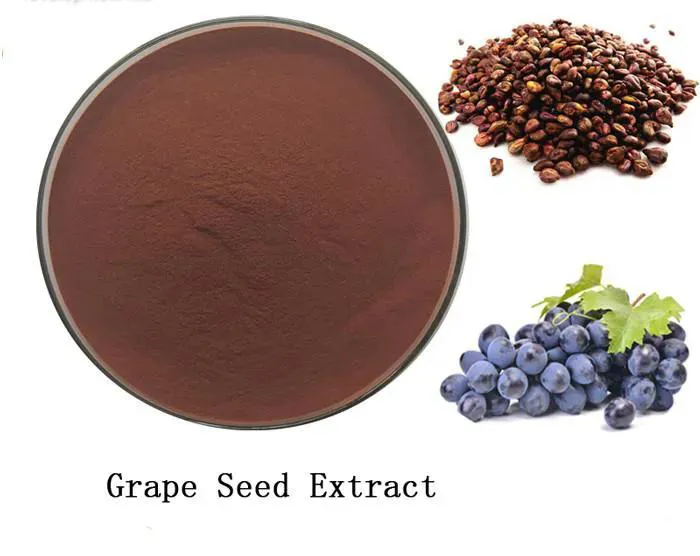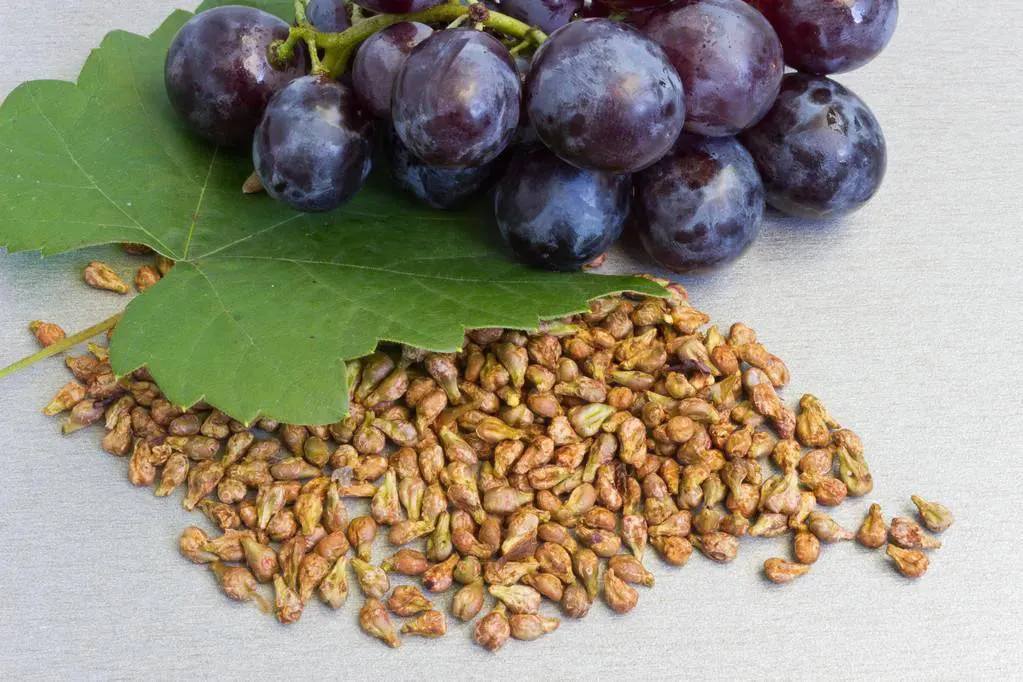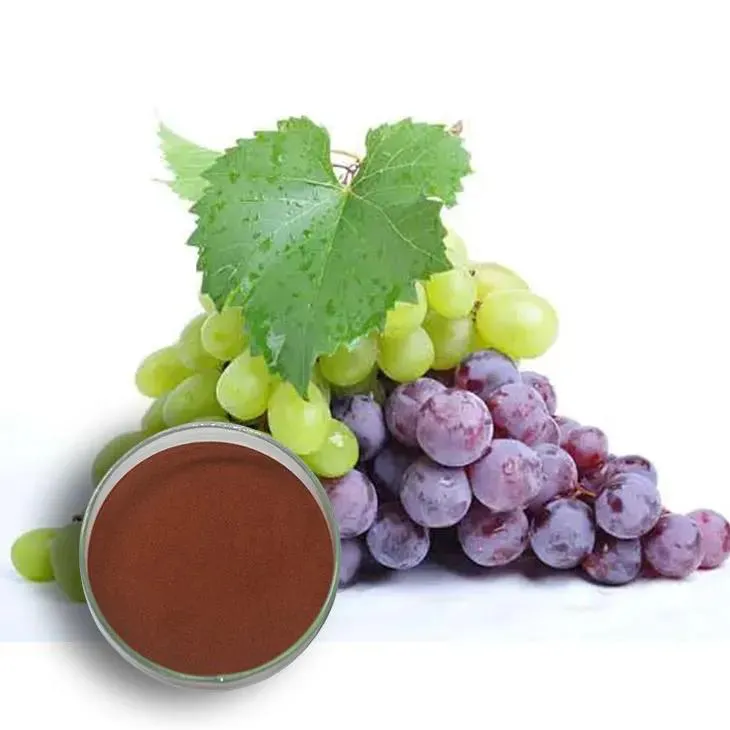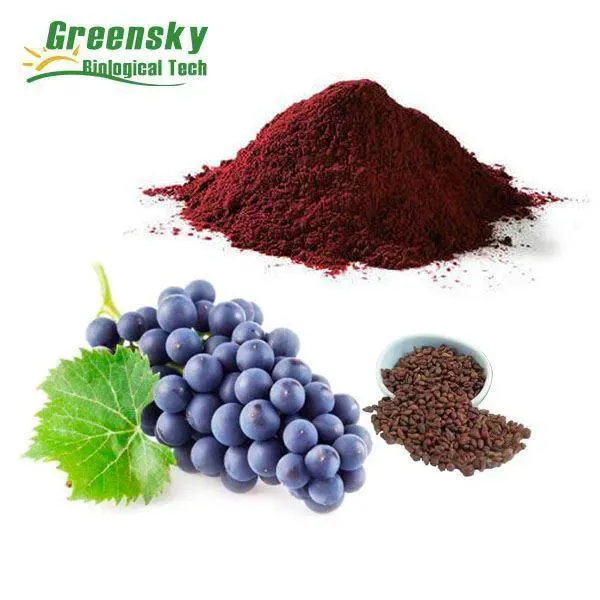- 0086-571-85302990
- sales@greenskybio.com
Revolutionizing Antimicrobial Treatment: Insights into Grape Seed Extract's Efficacy and Safety
2024-08-14

1. Introduction
In recent years, the search for alternative and effective antimicrobial agents has become a top priority in the field of medicine. The emergence of antibiotic - resistant bacteria has led to a significant challenge in treating infectious diseases. Grape Seed Extract (GSE) has emerged as a potential candidate with promising antimicrobial properties. This extract is rich in various bioactive compounds, especially polyphenols, which may contribute to its antimicrobial efficacy. Moreover, understanding its safety profile is crucial for its potential applications in different areas of antimicrobial treatment.

2. Composition of Grape Seed Extract
Grape Seed Extract is a complex mixture of various compounds. The most notable components are polyphenols, which include proanthocyanidins, flavonoids, and phenolic acids.
2.1 Proanthocyanidins
Proanthocyanidins are oligomers or polymers of flavan - 3 - ol units. They are present in high concentrations in grape seed extract. These compounds have antioxidant properties and may also play a role in antimicrobial activity. For example, they can disrupt the cell membranes of microorganisms, interfering with their normal physiological functions.
2.2 Flavonoids
Flavonoids such as Quercetin, kaempferol, and myricetin are also found in grape seed extract. Flavonoids are known for their antioxidant, anti - inflammatory, and antimicrobial activities. They can act by inhibiting the growth of microorganisms, either by interfering with their enzyme systems or by disrupting their cell structures.
2.3 Phenolic Acids
Phenolic acids like caffeic acid and ferulic acid contribute to the overall antioxidant and antimicrobial potential of grape seed extract. They can scavenge free radicals and also have antibacterial properties, which may be due to their ability to disrupt bacterial cell walls or membranes.

3. Efficacy of Grape Seed Extract in Antimicrobial Treatment
The antimicrobial efficacy of grape seed extract has been studied against a wide range of microorganisms, including bacteria, fungi, and viruses.
3.1 Against Bacteria
- Gram - positive bacteria: Studies have shown that GSE can inhibit the growth of Gram - positive bacteria such as Staphylococcus aureus and Streptococcus pyogenes. The polyphenolic compounds in GSE may disrupt the peptidoglycan layer of the bacterial cell wall, leading to cell lysis. For instance, in vitro experiments have demonstrated that a certain concentration of GSE can significantly reduce the viability of S. aureus colonies. - Gram - negative bacteria: GSE also exhibits antimicrobial activity against Gram - negative bacteria like Escherichia coli and Pseudomonas aeruginosa. Although Gram - negative bacteria have an outer membrane that provides an additional barrier, the components of GSE can still penetrate and affect their inner structures. For example, it may interfere with the bacterial membrane - associated proteins or disrupt the lipopolysaccharide layer.
3.2 Against Fungi
Fungal infections are also a significant concern in the medical field. Grape seed extract has been shown to have antifungal properties against various fungi, such as Candida albicans. The polyphenols in GSE can interact with the fungal cell membrane, causing changes in its permeability and ultimately leading to cell death. In addition, GSE may also interfere with the fungal cell wall synthesis, which is crucial for the survival of the fungus.
3.3 Against Viruses
While the research on the antiviral properties of GSE is still in its early stages, some studies have suggested potential antiviral activity. For example, GSE may inhibit the replication of certain viruses by interfering with the viral attachment to host cells or by modulating the host immune response. However, more in - depth research is needed to fully understand its antiviral mechanisms and effectiveness.

4. Mechanisms of Antimicrobial Action
The antimicrobial action of grape seed extract can be attributed to several mechanisms.
4.1 Membrane Disruption
As mentioned earlier, the polyphenolic compounds in GSE can disrupt the cell membranes of microorganisms. This disruption can lead to the leakage of intracellular components, such as ions and proteins, which are essential for the normal functioning of the cell. For bacteria, this can result in the loss of cell viability, while for fungi, it can cause changes in membrane - associated functions and ultimately cell death.
4.2 Inhibition of Enzyme Systems
GSE may also inhibit the enzyme systems of microorganisms. For example, it can interfere with enzymes involved in cell wall synthesis or energy production. By inhibiting these enzymes, the growth and survival of the microorganisms are severely affected. In bacteria, this may prevent the formation of a proper cell wall, making them more vulnerable to environmental stresses.
4.3 Modulation of the Immune Response
Another possible mechanism is the modulation of the host immune response. GSE may enhance the immune system's ability to fight against infections. It can stimulate the production of immune cells, such as macrophages and lymphocytes, and also increase the production of cytokines, which are important signaling molecules in the immune response. This enhanced immune response can help in clearing the microorganisms more effectively.

5. Safety of Grape Seed Extract in Antimicrobial Applications
When considering the use of grape seed extract in antimicrobial treatment, its safety profile is of utmost importance.
5.1 General Toxicity
- In vitro studies have generally shown that GSE has low toxicity to normal human cells at concentrations effective against microorganisms. However, high - dose exposure may still cause some cytotoxic effects. For example, in some cell culture experiments, extremely high concentrations of GSE were found to slightly affect the viability of certain normal cell lines. - In vivo studies in animals have also suggested a relatively safe profile of GSE. When administered at appropriate doses, no significant adverse effects on major organs such as the liver, kidney, and heart were observed. However, long - term and high - dose studies are still needed to fully evaluate its safety.
5.2 Allergic Reactions
Although rare, allergic reactions to GSE may occur in some individuals. Grape - related allergies are more common in people with a history of food allergies. The components in GSE may trigger an allergic response, such as skin rashes, itching, or respiratory symptoms in sensitive individuals. Therefore, it is important to conduct proper allergy tests before using GSE in a large - scale antimicrobial treatment.
5.3 Interaction with Other Medications
GSE may interact with other medications, which is another aspect of its safety consideration. For example, it may affect the absorption or metabolism of certain drugs. Since GSE has antioxidant properties, it may interact with drugs that are metabolized by oxidative enzymes. Therefore, when using GSE in combination with other medications, careful monitoring and appropriate dosage adjustments may be necessary.
6. Applications of Grape Seed Extract in Antimicrobial Therapy
The potential applications of grape seed extract in antimicrobial therapy are diverse.
6.1 Topical Applications
- In the treatment of skin infections, GSE can be formulated into creams or ointments. For example, in cases of minor skin infections caused by bacteria or fungi, a topical application of GSE - based products may help in reducing inflammation and promoting wound healing. The antimicrobial properties of GSE can prevent the spread of the infection, while its antioxidant properties can help in protecting the skin cells from further damage. - In oral health, GSE can also be used in mouthwashes or toothpastes. It can help in preventing and treating oral infections, such as gingivitis and periodontitis. The antibacterial and antifungal activities of GSE can target the microorganisms responsible for these oral diseases, improving oral hygiene.
6.2 Systemic Applications
- In the treatment of systemic infections, although more research is needed, GSE may potentially be used as an adjunct to conventional antibiotics. By combining GSE with antibiotics, it may enhance the overall antimicrobial efficacy and help in reducing the development of antibiotic - resistant bacteria. For example, in some in vitro studies, the combination of GSE and certain antibiotics showed a synergistic effect against resistant strains of bacteria. - GSE may also be explored for its potential in preventing hospital - acquired infections. In hospital settings, the risk of infections is high, and alternative antimicrobial agents are needed. GSE, with its broad - spectrum antimicrobial properties, could be a candidate for developing preventive strategies.
7. Future Perspectives
Despite the promising potential of grape seed extract in antimicrobial treatment, there are still several areas that need further research.
7.1 Understanding the Mechanisms in More Detail
Although some mechanisms of GSE's antimicrobial action have been proposed, a more in - depth understanding is required. For example, the exact interactions between the polyphenolic compounds in GSE and the specific targets in microorganisms need to be elucidated. This will help in optimizing the use of GSE for antimicrobial treatment and may also lead to the development of more effective derivatives.
7.2 Clinical Trials
More well - designed clinical trials are needed to evaluate the efficacy and safety of GSE in different antimicrobial applications. These trials should include a large number of participants and compare GSE with standard antimicrobial therapies. The results of these trials will be crucial for determining the practical value of GSE in clinical settings.
7.3 Development of Novel Formulations
To improve the bioavailability and effectiveness of GSE, novel formulations need to be developed. For example, nanoparticle - based formulations may enhance the delivery of GSE to the target sites in the body. This will not only increase its antimicrobial activity but also reduce potential side effects.
8. Conclusion
Grape seed extract has shown significant potential in revolutionizing antimicrobial treatment. Its rich polyphenolic content endows it with antimicrobial efficacy against bacteria, fungi, and potentially viruses. The multiple mechanisms of action, including membrane disruption, enzyme inhibition, and immune modulation, contribute to its effectiveness. However, its safety aspects, such as general toxicity, allergic reactions, and drug interactions, need to be carefully considered. With further research in understanding the mechanisms, conducting clinical trials, and developing novel formulations, grape seed extract could play an important role in the future of antimicrobial therapy, especially in the face of the growing problem of antibiotic - resistant microorganisms.
FAQ:
What are the main components in grape seed extract that contribute to its antimicrobial efficacy?
The main components in grape seed extract that contribute to its antimicrobial efficacy are polyphenols. These polyphenols possess various properties that can interfere with the growth and survival of microorganisms. For example, they may disrupt the cell membranes of bacteria or fungi, inhibit their metabolic processes, or interfere with their ability to adhere to surfaces.
How does grape seed extract compare to traditional antimicrobial agents in terms of efficacy?
Grape seed extract has some unique features compared to traditional antimicrobial agents. In some cases, it may have a broader spectrum of activity against different types of microorganisms. However, traditional antimicrobial agents often have a more established and well - studied mechanism of action. While grape seed extract's efficacy is promising, it may not always be as potent as some of the highly targeted traditional drugs. But it could potentially be used in combination with traditional agents to enhance overall antimicrobial treatment.
What safety considerations should be taken into account when using grape seed extract for antimicrobial treatment?
When using grape seed extract for antimicrobial treatment, several safety considerations are important. Firstly, allergic reactions may occur in some individuals, especially those with a history of allergies to grapes or related products. Secondly, the dosage needs to be carefully determined as excessive amounts may lead to potential adverse effects. Additionally, if used in combination with other medications, there may be interactions that need to be monitored. It is also crucial to ensure that the source of the grape seed extract is reliable and free from contaminants.
Can grape seed extract be used to treat antibiotic - resistant bacteria?
There is evidence to suggest that grape seed extract may have potential in treating antibiotic - resistant bacteria. Its different mode of action compared to traditional antibiotics means it may be able to target bacteria that have developed resistance to common drugs. However, more research is needed to fully understand its effectiveness against specific resistant strains and to develop appropriate treatment protocols.
What are the current limitations in the use of grape seed extract for antimicrobial treatment?
The current limitations in the use of grape seed extract for antimicrobial treatment include the lack of standardized dosages for different types of infections. There is also a need for more in - vivo studies to accurately determine its efficacy in living organisms. Additionally, the long - term effects of its use are not well - understood. Another limitation is the relatively limited research on its effectiveness against a wide range of microorganisms compared to traditional antimicrobial agents.
Related literature
- Antimicrobial Activity of Grape Seed Extract: A Review"
- "Grape Seed Extract: Efficacy, Safety and Potential Applications in Antimicrobial Therapy"
- "The Role of Grape Seed Polyphenols in Combating Microbial Infections"
- ▶ Hesperidin
- ▶ citrus bioflavonoids
- ▶ plant extract
- ▶ lycopene
- ▶ Diosmin
- ▶ Grape seed extract
- ▶ Sea buckthorn Juice Powder
- ▶ Beetroot powder
- ▶ Hops Extract
- ▶ Artichoke Extract
- ▶ Reishi mushroom extract
- ▶ Astaxanthin
- ▶ Green Tea Extract
- ▶ Curcumin Extract
- ▶ Horse Chestnut Extract
- ▶ Other Problems
- ▶ Boswellia Serrata Extract
- ▶ Resveratrol Extract
- ▶ Marigold Extract
- ▶ Grape Leaf Extract
- ▶ blog3
-
Sea buckthorn Juice Powder
2024-08-14
-
Kelp Extract Powder
2024-08-14
-
Saponin Extract
2024-08-14
-
Chaste Berry Extract
2024-08-14
-
Uridine-5'-monophosphate Disodium salt
2024-08-14
-
Golden Seal Extract
2024-08-14
-
Pomegranate Extract
2024-08-14
-
Nettle Root Extract
2024-08-14
-
Red Vine Extract
2024-08-14
-
Longan Extract
2024-08-14





















